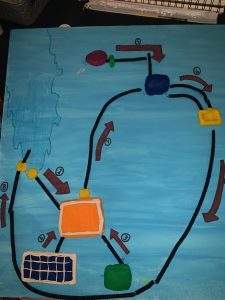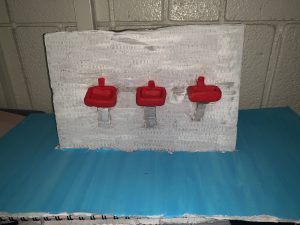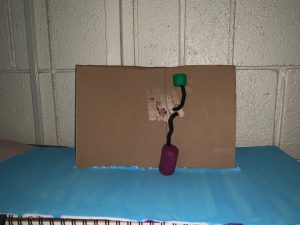May
1
Checkpoint 3; Draft Model of Our Solution
May 1, 2019 | Leave a Comment
Checkpoint 3; Ebola Outbreak in DRC Potential Solution: Chlorinated Automatic Hand Washing Faucet
For our solution on fighting Ebola, we decided to come up with a solution that would help medical professionals fight germs at a faster and more effective rate by creating a hand-washing station. This station contains products and materials that are cost effective, and energy efficient. The types of pipes we have decided to use are Polyvinyl Chloride Pipes, as they are budget-friendly, effective at carrying high water pressures, and has good longevity and performance at up to 100 years. They also are anti chorosive.
First, we would use a local source of water, such as a river or stream. Then, we decided to integrate a pipe into this body of water which will contain a carbon filter, which will filter out the water. Carbon water filters remove contaminants, odor, and bad taste. 81 chemicals can be removed from the filters. One gram of carbon is 5,000-30,000 square feet and 4 grams is equal to a football field. Due to its large surface area, carbon filters are very effective in adsorbing and removing contaminants and other substances. The concern for Ebola residing in the water is not an issue because Ebola is killed in water within seconds. This pipe, after going through a filter, will connect to a water pump. This water pump will be powered by solar panels mainly, however we also have a backup generator in case there is no direct sunlight available. After this water pump is powered, it will go through one more filter to insure that the water is pure. It will then travel through another pipe which will connect directly into a water tank. This water tank will also have another pipe which is pumping chlorine from a chlorine tank. This chlorine pipe contains a throttle valve, which will control the amount of chlorine going into this water tank to prevent too much chlorine going into this tank. After this tank reservoir is full, there will be a pipe blocker in the pipe that sits in the local body of water, which will close off when it senses this tank is full to prevent overflowing and to conserve water. After this, there will be another pipe connecting from the water tank which will lead into three valves that will connect to our sinks. After the sinks have been used, there will be one last pipe which will connect back into the river. There will also be a filter at the end of this pipe which will prevent any backflow water from infiltrating our main water tank and potentially contaminating it. As the ebola virus does not survive in water, we will not need to use a filter that filters out viruses from used water. The carbon filter is simply to help reduce bacteria since we plan to send the water back to its original source. We will follow the CDC’s guidelines in adding chlorine to water, and only create a solution with 0.05% chlorine to water, as stronger solutions are not necessary and can chlorine burns to bare skin. The solution will be installed in local medical facilities where equipment and sanitation methods are not readily available, to help stop the spread of the disease from where people are often treated. The medical workers in these facilities are often too important to the community for their clinic to be shut down, despite the lack of adequate sanitation.
The first picture is a model diagram explaining the process; where the water comes from, how we will achieve accurate pressure, etc. The second picture is a model of the actual sinks. The third picture is the other side of the wall where the sinks are installed, showing the water tank and the chlorine tank. We will install three automatic sinks, to reduce traffic should multiple people need to use the sink at once.
Key explaining each number on the diagram:
- Water comes from body of water, or water tank if no suitable water source is close by enough. This source will feed water into the water pump through pipes, and a carbon filter will be installed to ensure that the water is clean enough to drink.
- The solar panel will power the water pump as its main source, to reduce electricity costs.
- If there is no sunlight, a generator will be used as a backup source of power.
- Another carbon filter will lead another pipe out of the pump, to double-check that the water is completely pure.
- There will be a chlorine tank(in purple) that will lead chlorine into the main water tank(in blue). A throttle valve(in green) will be installed to ensure that the right amount of chlorine is in the water, and prevent over contamination.
- Pipe from the water tank, with the water-chlorine solution already mixed, will then lead into the sinks.
- Used water will connect into another pipe which will connect back into the stream.
- Another carbon filter will be installed at the end of this final pipe to ensure that no bacteria from the hands of users, or chlorine will re-enter the water source.



Sources:
Aquagenx. (n.d.). Facts about the Ebola Virus and Drinking Water. Retrieved from https://www.aquagenx.com/wp-content/uploads/2014/10/^Ebola-Virus-and-Drinking-Water-Tech-Brief.pdf
Swartz, N. (2016, October 27). How Everything in an RV Works on Wand’rly. Retrieved from https://wandrlymagazine.com/article/how-everything-in-an-rv-works/#water-system
CDC. (2015, February 27). For General Healthcare Settings in West Africa: How to Prepare and Use Chlorine Solutions. Retrieved from https://www.cdc.gov/vhf/ebola/hcp/mixing-chlorine-solutions.html
BBC News. [BBC News]. (2019, March 7). Ebola in the DR Congo warzone – BBC News [Video File]. Retrieved from https://www.youtube.com/watch?v=fGESslPLluo
Bohora, K. (2018, November 25). Pros and cons of using PVC pipe in Plumbing. Retrieved from
https://www.everestplumbing.ca/pros-and-cons-of-using-pvc-pipe-in-plumbing/
What does activated carbon water filters remove? (2019, April 7). Retrieved from https://tappwater.co/us/what-activated-carbon-remove/
Speak your mind